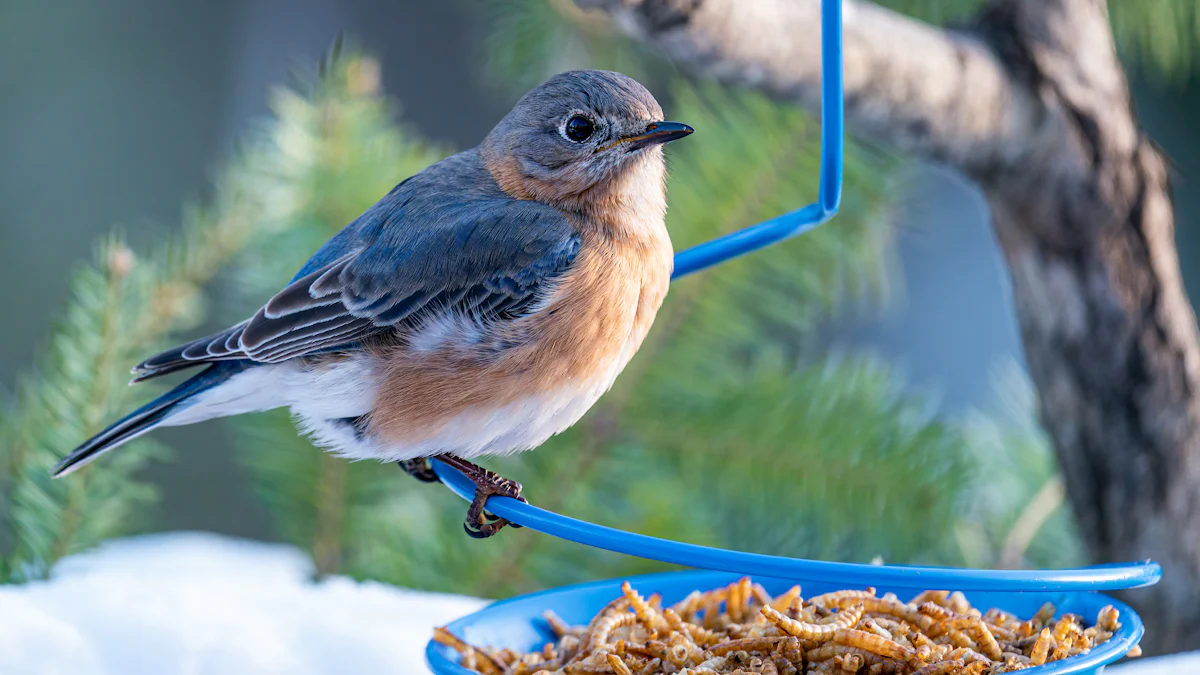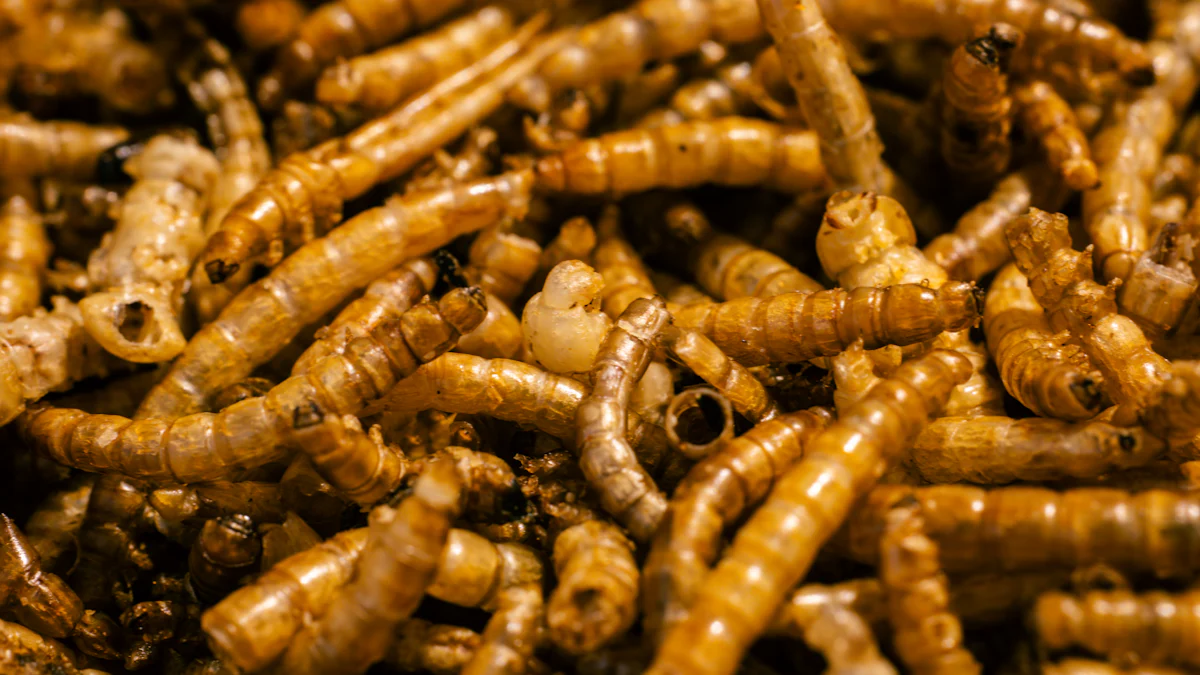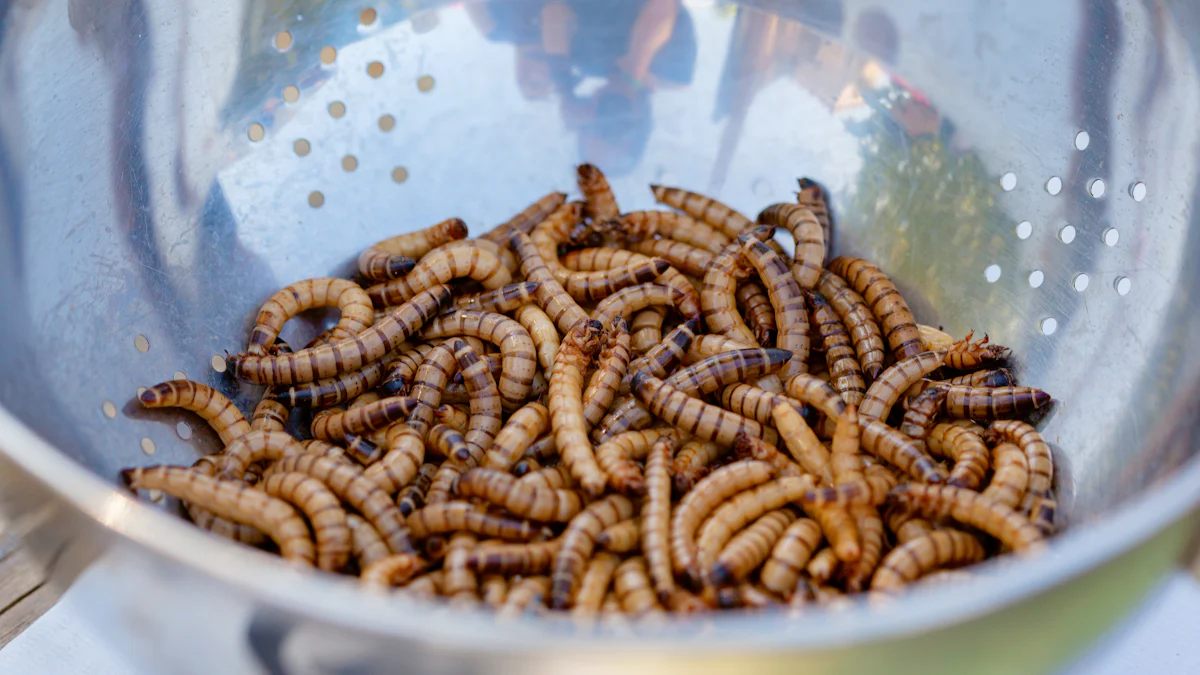
Feeding mealworms dried to birds and pets is one of the easiest ways to boost their health. These little treats are packed with protein and energy, which help birds grow strong feathers and lay more eggs. They also support young birds’ development and keep wild birds energized during tough seasons like winter. For pets, mealworms encourage natural eating habits and provide a tasty, nutritious snack. Proper feeding ensures your animals stay happy and healthy while avoiding any risks.
Key Takeaways
- Dried mealworms are a protein-rich snack that boosts the health of birds and pets. They support growth, feather quality, and energy levels.
- Proper storage of mealworms is essential. Keep them in a cool, dry place to maintain freshness and prevent spoilage.
- Moderation is key when feeding mealworms. Limit them to 10-15% of your pet’s diet to ensure a balanced nutrition.
Nutritional Benefits of Mealworms Dried

High Protein and Energy Content
When it comes to protein-packed snacks, mealworms dried are hard to beat. Did you know they contain about 50-60% protein by weight? That’s incredible! This makes them a fantastic choice for animals that need a protein boost, like birds, reptiles, and even fish. For comparison, their protein content is almost on par with soy, which has around 50%.
But it’s not just about protein. Mealworms dried also provide healthy fats, which are essential for energy. These fats are especially helpful for birds during breeding, egg-laying, or migration. Whether it’s a cold winter or a busy nesting season, these little treats give animals the energy they need to thrive.
Essential Nutrients for Growth and Health
Mealworms dried are more than just protein and fat. They’re packed with essential nutrients that support overall health. For example:
- Amino Acids: These are critical for growth, maintenance, and reproduction.
- B Vitamins: Especially B12, which helps with energy metabolism and red blood cell production.
- Minerals: Iron, zinc, and magnesium strengthen bones and boost the immune system.
These nutrients make mealworms dried a well-rounded option for promoting muscle development, feather health, and vitality. They’re like a multivitamin for your pets or backyard birds!
Advantages for Birds and Pets
I’ve seen firsthand how mealworms dried can transform an animal’s diet. Birds love them, and they’re perfect for young ones who need extra nutrition to grow strong. They also help adult birds produce more eggs and stay energized during tough seasons. For pets like reptiles or small mammals, mealworms dried are a convenient, protein-rich snack that mimics their natural diet.
What’s even better? They’re easy to store and don’t require any special care. You can mix them with other foods or offer them as a standalone treat. Either way, they’re a simple way to keep your animals happy and healthy.
How to Feed Mealworms Dried
Choosing the Right Feeder
Picking the right feeder makes a big difference when serving mealworms dried to your birds or pets. I’ve found that feeders with tall sides work best because they keep the mealworms from spilling out. If you’re feeding birds outdoors, look for a feeder with a roof or rain guard. This keeps the mealworms dry and fresh, even during bad weather.
Drainage holes are another must-have. They stop water from pooling at the bottom, which could ruin the mealworms. For added safety, tamper-resistant feeders help keep unwanted critters like squirrels or raccoons away.
You can also try different feeding methods. A tray feeder designed for mealworms works great. Mixing mealworms with other bird food in a dish or saucer is another option. Experiment and see what works best for your animals!
Soaking vs. Dry Feeding
Should you soak mealworms dried or serve them as-is? It depends on your animals’ needs. Soaking softens the mealworms, making them easier to eat. This is especially helpful for baby birds or pets with sensitive teeth. Just soak them in warm water for about 10-15 minutes before serving.
Dry feeding, on the other hand, is super convenient. It’s perfect for adult birds and pets that can handle crunchier textures. I usually keep a mix of both options on hand to cater to different animals.
Seasonal Feeding Strategies
Feeding strategies can change with the seasons. During winter, birds need extra energy to stay warm. I like to offer more mealworms dried during this time to help them out. In spring, when birds are nesting, mealworms provide the protein they need for egg-laying and feeding their chicks.
In summer, I cut back a bit since natural food sources are more abundant. Fall is another important time to feed mealworms, as birds prepare for migration. Adjusting your feeding routine based on the season keeps your animals healthy year-round.
Animals That Can Eat Mealworms Dried

Birds Commonly Attracted to Mealworms
If you’ve ever put out mealworms dried in your yard, you’ve probably noticed how quickly birds flock to them. They’re like candy for many bird species! Bluebirds, robins, and wrens are some of the most common visitors. I’ve also seen woodpeckers and chickadees enjoy them. During migration, even warblers and orioles might stop by for a snack.
Mealworms are especially helpful for birds raising chicks. Parents love feeding them to their young because they’re packed with protein. If you want to attract more feathered friends, try adding mealworms to your feeder. It’s a surefire way to make your backyard a bird paradise.
Pets That Benefit from Mealworms
Mealworms dried aren’t just for wild birds. They’re also a fantastic treat for many pets. Here’s a quick list of animals that benefit the most:
- Poultry like chickens and ducks
- Reptiles such as bearded dragons and leopard geckos
- Small mammals like hedgehogs and sugar gliders
- Fish, including koi and goldfish
- Turtles and lizards
These pets love mealworms because they mimic their natural diet. Plus, they’re loaded with nutrients like amino acids and vitamins that support growth and health. I’ve found that even picky eaters can’t resist them. Whether you have a backyard flock or a scaly friend, mealworms are a great addition to their diet.
Other Wildlife That May Consume Them
Mealworms dried can also attract other wildlife to your yard. Squirrels, hedgehogs, and even turtles enjoy them. I’ve seen lizards and sugar gliders nibble on them too. If you live near water, fish might also take a liking to mealworms.
Offering mealworms can help support local wildlife, especially during tough seasons. Just be mindful of how much you’re putting out. You don’t want to attract unwanted critters like raccoons. A little goes a long way when it comes to feeding wildlife responsibly.
Storage and Handling of Mealworms Dried
Best Practices for Storage
Storing mealworms dried properly keeps them fresh and nutritious for your animals. I always make sure to rotate my stock regularly. This way, I use the older mealworms first and avoid waste. Moisture is the enemy here, so I store them in a cool, dry place with humidity below 50%. If I have extra mealworms, I freeze them in a clean, airtight bag. Freezing at temperatures below -15°C keeps them fresh for over six months.
For short-term storage, refrigeration works great. It slows down spoilage and keeps the mealworms ready to use. I also check for pests or signs of spoilage often. A quick look ensures my mealworms stay safe and high-quality.
Maintaining Freshness and Hygiene
Keeping mealworms dried fresh and clean is easier than you think. I always store them at 40-50°F (4-10°C) to maintain their quality. Ventilation is key, so I use containers with small holes for airflow. This prevents condensation, which can lead to mold.
I also use bedding materials like wheat bran or oatmeal. These help absorb moisture and keep the mealworms dry. To avoid waste, I follow a first-in, first-out system. This means I use the oldest mealworms first. Regularly checking for unusual smells or discoloration helps me catch any issues early.
Understanding Shelf Life
Mealworms dried can last a long time if stored correctly. Typically, they stay fresh for one to two years. However, vacuum-sealed packaging can extend their shelf life even further. I’ve seen some brands claim their mealworms last up to five years when stored in airtight containers.
To get the most out of your mealworms, keep them in a cool, dry place away from sunlight. Temperatures below 70°F (21°C) work best. If you’re not using them right away, resealable bags or vacuum-sealed containers are a great option. This keeps them fresh and full of nutrients for your pets or backyard birds.
Precautions When Feeding Mealworms Dried
Avoiding Overfeeding
Overfeeding mealworms dried can cause more harm than good. I always remind myself that moderation is key. Birds and pets love these treats, but too many can lead to an imbalanced diet. For birds, I make sure mealworms make up only 10% to 15% of their overall diet. This way, they still eat other essential foods like seeds, fruits, or insects.
To avoid overfeeding, I mix mealworms with regular bird food. This keeps their diet balanced and prevents them from ignoring other nutrients. If you’re unsure how much to feed, consulting a veterinarian is a smart move. They can guide you on the right amount for your specific pet or bird species.
Preventing Unwanted Wildlife Attraction
Mealworms dried can attract more than just birds and pets. I’ve noticed squirrels, raccoons, and even stray animals sniffing around when I leave too much out. To prevent this, I use tamper-resistant feeders. These feeders keep the mealworms safe and limit access to unwanted visitors.
Another tip is to avoid overfilling feeders. I only put out what my animals can eat in a day. This reduces leftovers that might attract wildlife. Feeding during the day also helps since nocturnal animals are less likely to show up.
Ensuring Suitability for Specific Animals
Not all animals benefit equally from mealworms dried. Before feeding, I always check if they’re suitable for the species I’m caring for. For example, mealworms are perfect for poultry, wild birds, reptiles, and even sugar gliders. They’re packed with protein, healthy fats, and essential vitamins like B12 and iron.
Here’s a quick breakdown of their nutrients:
| Nutrient | Description |
|---|---|
| Protein | Essential for muscle growth and repair. |
| Fat | Provides energy for active animals. |
| Fiber | Supports healthy digestion. |
| Vitamins and minerals | Boosts immunity and strengthens bones. |
| Omega-3 fatty acids | Improves egg quality and overall health. |
This table helps me understand why mealworms are such a great choice. However, I always double-check with a vet if I’m introducing them to a new animal.
Feeding mealworms dried to birds and pets offers incredible benefits. They’re packed with protein, fats, and essential nutrients that improve growth, feather quality, and overall health. Long-term use even boosts immune function and reduces reliance on antibiotics.
Storing mealworms correctly is crucial for anyone using them as feeder insects. Proper storage practices help maintain their freshness and viability for extended periods.
To keep them fresh, I always follow best practices like storing them in a cool, dry place. This ensures my animals get the highest quality nutrition while minimizing waste. Responsible feeding, storage, and precautions make mealworms a reliable and sustainable food source. Why not try adding them to your routine today? Your pets and backyard birds will thank you!
FAQ
Can I feed dried mealworms to baby birds?
Yes, but soak them first. Soaking softens the mealworms, making them easier for baby birds to eat and digest.
How often should I feed mealworms to my pets?
Feed them as treats, not meals. Limit mealworms to 10-15% of your pet’s diet to maintain balance.
Do dried mealworms attract pests?
They can if left out too long. Use tamper-resistant feeders and only put out what animals can eat in a day.
Post time: Jan-28-2025
